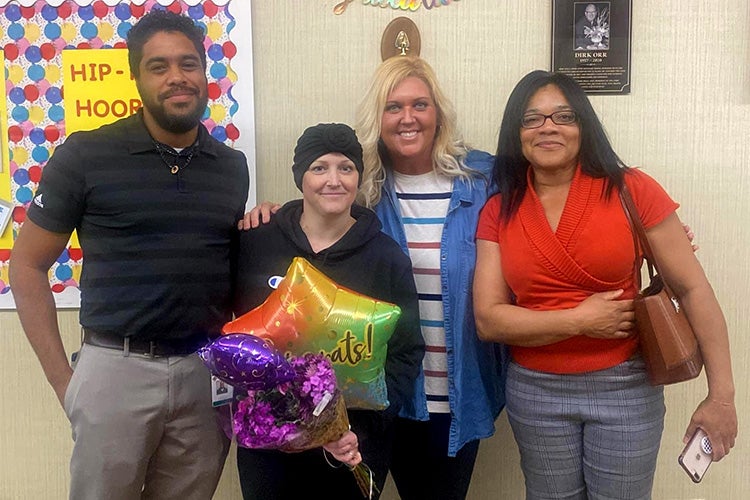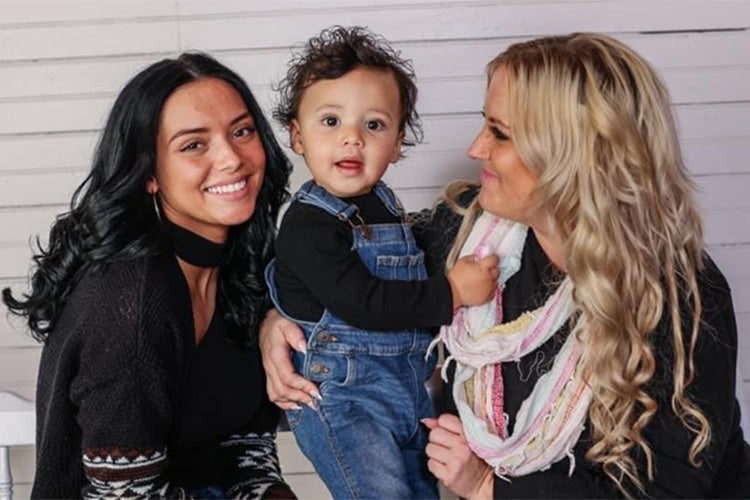Positive Mindset, New Technology Take Permanence Away From Breast Cancer Treatment
August 13, 2024
Categories: Blog Posts, Survivorship Stories
When 37-year-old Nicole Coon was diagnosed with breast cancer last November, her first thought wasn’t about the cosmetic implications of treatment. It was about her daughter.
“The first thing that came to my mind was, how does this affect her,” she recalled. “There was shock and fear of the unknown later, but she was my first concern.”
And while that concern never goes away for moms like Coon, it’s been allayed by the immediacy and efficiency of the treatment she’s received at Mount Carmel, where she also happens to be a nurse.
Within four days of finding a lump, she was in with breast specialist Dr. Kristine Slam. She had surgery at the end of May after six months of chemotherapy and is now in the middle of four weeks of radiation using a brand new treatment technology called Surface Guided Radiation Therapy (SGRT). It’s a system that improves treatment setup and accuracy by tracking a patient’s body position before and during radiation therapy.
Before SGRT, patients undergoing radiation treatment like Coon would need to have permanent marks (commonly referred to as tattoos) made on their bodies, along with an array of restrictive stickers, to ensure treatment was delivered to the precise location. For some, those tattoos are not only painful but an unwanted lifelong reminder of their cancer treatment.
SGRT, by contrast, is non-invasive and contact-free, using 3D stereo cameras to track the skin’s surface and compare it to the ideal position in the treatment plan. It completely eliminates the need for tattoos and can also automatically signal the treatment delivery system to pause the radiation beam if the patient moves out of position. That improves accuracy and reduces treatment time, which Coon and her busy schedule absolutely appreciate.

“You start with a simulation that pretty much memorizes your body,” she said. “It finds the treatment location with a light and then monitors your breathing and other movements and ‘marks’ you. If you move or even cough during treatment, it stops, resets, and doesn’t start again until you’re back in place. It’s really easy.”
And efficient.
“I’m having treatments Monday through Friday and I think they take about 15 minutes now,” she chuckled. “That’s a big help when it comes to scheduling, especially for women who are working. I think it takes longer for me to get ready than it does to get treated.”
Not that she’s rushing through treatment. She really enjoys her care team and the personal approach they take to the patient’s experience.
“They treat me with so much compassion,” said Coon, “and as a nurse I know how challenging their job is. That makes the experience so much easier. They’ve even given me Kroger gift cards and coupons to help cover the cost of meal replacement shakes to help keep my weight up.”
That squares with the energy she’s gotten from her Mount Carmel colleagues, too, who generously started a GoFundMe campaign to help her with expenses and can be seen decked out in “Team Nicole” t-shirts.
“They’re a second family to me,” she smiled. “They’ve been all-in with me since the beginning.”
With only a couple more weeks of radiation remaining and a final few months of target immune therapy to come, she can see the light at the end of the tunnel and lots of encouraging signs.
“Keeping a positive mindset has been key,” she suggested. “It affects the body and how we handle things. I know it’s made a difference for me.”
And for her first thought, always, her daughter.
Mount Carmel is the first health system in central Ohio to offer Surface-Guided Radiation Therapy for breast cancer. To learn more about the technology and cancer care at Mount Carmel, visit Cancer Care.
